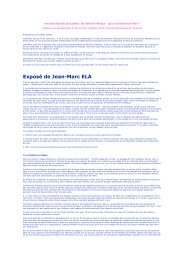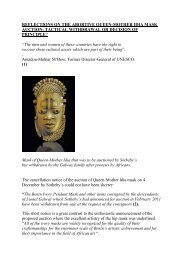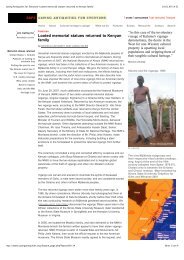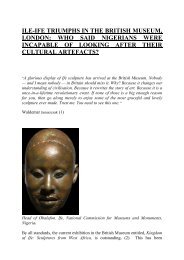White charity
White charity
White charity
- No tags were found...
You also want an ePaper? Increase the reach of your titles
YUMPU automatically turns print PDFs into web optimized ePapers that Google loves.
consider white people as the norm.projection: The denial of one's own dependency on the Other results in a projection onto the Other.Practically speaking this means that as it is psychologically and politically not possible toacknowledge a white dependency on the black subject, charities construct the depicted black peopleas dependent. Tißberger (2006: 91) argues that this strategy of projection is used in a more generalsense, through “transfer[ing] internal conflicts (e.g. contradictions within a society) on to others.”After the piecemeal dismantlement of the social care system in Germany, poverty is a rising issue ininternal debates. Hence, with the projection of poverty into the African Savannah charities support aconservative discourse within Germany and position the whole country as rich.In the last chapter, I argued with Barthes that through a de-politicised understanding of the world,whiteness evokes passivity of the white subject. In <strong>charity</strong> advertisements, in contrary, black peopleare portrayed as passive. I assess this phenomenon as another form of projection.abjection: Following Kristeva (in Tißberger 2006: 89) <strong>charity</strong> organisations mark black people asdifferent, declare them as impure and position them in “certain threshold zones” (McClintock 1995:72) outside the norm. Through this process of abjection, a white German normality is constructed.McClintock (1995: 72) argues that “[a]bject peoples are those whom industrial imperialism rejectsbut cannot do without”. Charities portray black people according to this logic: they are renderedabnormal, however, stay available for white psychological and material needs.fantasies: The one who has the power of representation, has the possibility to diffuse her/hisfantasies. For example, I select one fantasy of the colonizer: the muteness of the colonized(Kilomba 2005: 81). Out of all the analysed material there is not one advertisement in which ablack person is uttering something her/himself. Constantly, the charities silence black subjects andspeak in their name. Other fantasies which charities are able to diffuse through theirrepresentational power and their access to resources are e.g. the fantasies of black people as objects,as passive, as apolitical 58 or as inherently happy. 59Barthes' MythologiesI deem <strong>charity</strong> ads as promoters of the myth of white superiority. They form part of a narrative thatis needed for the construction of an illusory white identity (Goudge 2003: 170). The images ofracialised black people can be considered as form in Barthes' system of myth; as a medium for the58 With the reduction of black subjects on suffering, the white fantasy that black people are apolitical is nourished. Theexistence of political resistances and a complex network of local NGOs, social movements and political projects istherewith ignored.59 One favourite topic of depiction is the 'black-kid-as-grinning'. Hutnyk (1996: 57) questions the depiction of 'poor-asbeautiful'.Goudge (2003: 148f, 169) argues that this positive essentialism has to be seen as a strategy of power, asboth positive and negative stereotypes fix the Other in rigid stereotypes.28














